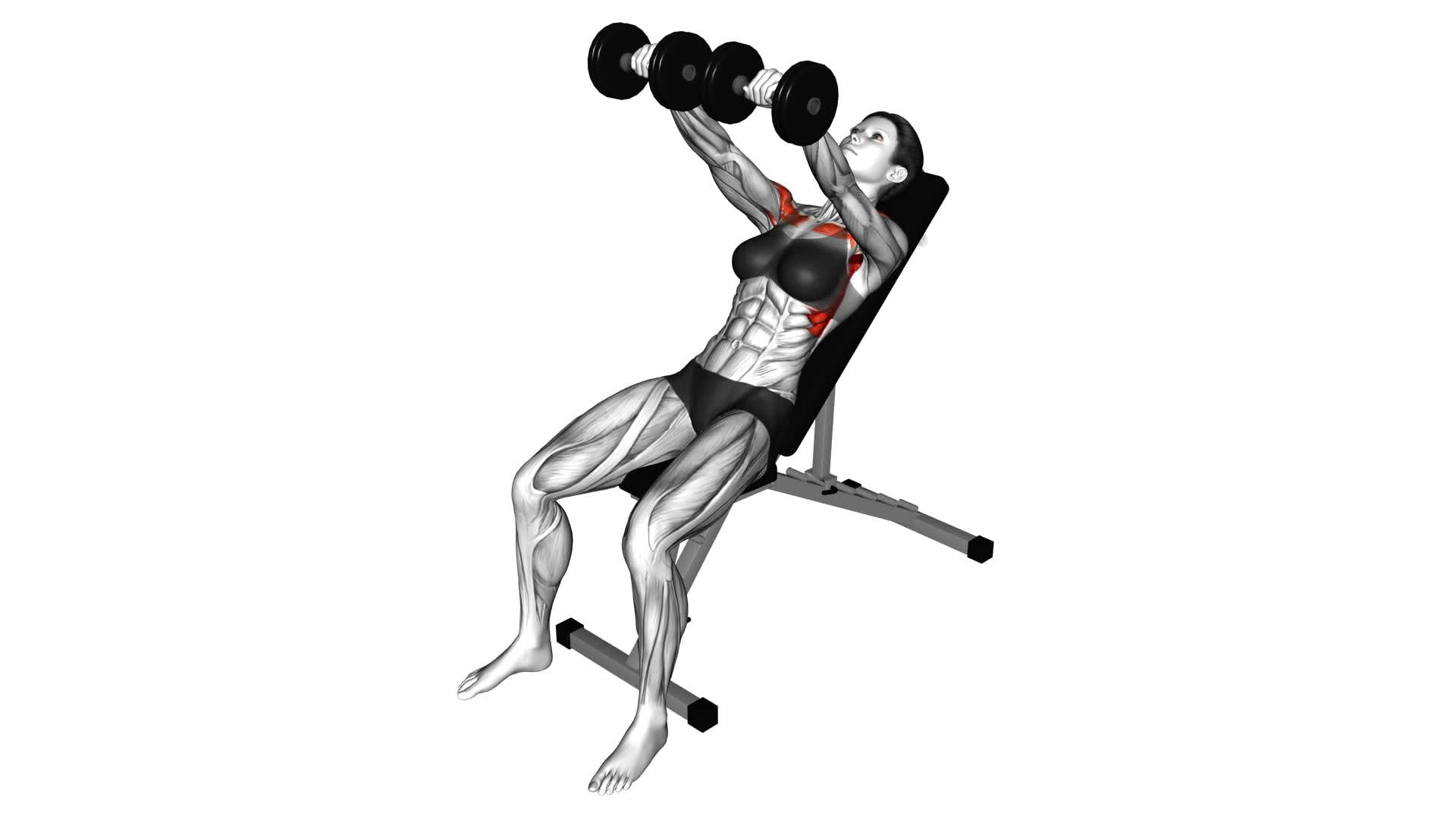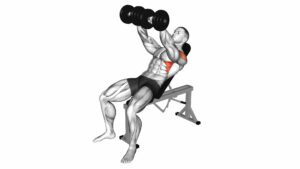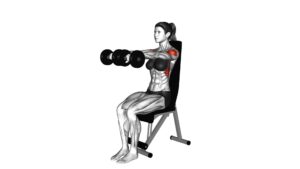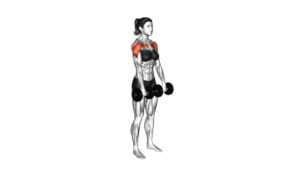Dumbbell Incline Front Raise (female) – Video Exercise Guide & Tips

Are you looking to strengthen your shoulder muscles and improve your upper body strength? If so, the dumbbell incline front raise is the perfect exercise for you.
Watch This Exercise Video
In this video exercise guide, we will show you the proper form and technique to perform this exercise effectively. With just a few simple steps, you can target and tone your shoulders for maximum results.
Get ready to feel the burn and achieve your fitness goals!
Key Takeaways
- Maintain proper form and technique throughout the exercise
- Start with a light weight to ensure proper form and prevent injury
- Focus on engaging the shoulder and upper back muscles
- Gradually increase weight and intensity to continue challenging your muscles
Proper Form and Technique
To perform the dumbbell incline front raise correctly, maintain proper form and technique throughout the exercise. This exercise targets your anterior deltoids and can help improve your shoulder strength and stability.
When performing the dumbbell incline front raise, make sure to start with a light weight to ensure proper form and prevent injury. Stand with your feet shoulder-width apart, holding a dumbbell in each hand. Lean back on an incline bench set at a 45-degree angle, keeping your back straight and core engaged.
With a slight bend in your elbows, raise the dumbbells in front of you until they're parallel to the ground. Avoid swinging your body or using momentum to lift the weights. Control the movement and focus on engaging your shoulder muscles throughout the exercise.
Common errors to avoid include lifting the weights too high, shrugging your shoulders, or arching your back. Remember to breathe and exhale as you lift the weights.
Experiment with different variations, such as using a resistance band instead of dumbbells or performing the exercise seated instead of on an incline bench, to target your muscles in different ways.
Proper form and technique are essential to maximize the benefits of the dumbbell incline front raise and prevent injury.
Equipment Needed
You will need a pair of dumbbells for the dumbbell incline front raise exercise. Dumbbells are versatile and effective tools for strength training, and they come in various types to suit your preferences and fitness goals.
Here are the different types of dumbbells you can use:
- Fixed-weight dumbbells: These are the most common type, with a fixed weight that can't be adjusted. They're available in a range of weights, allowing you to choose the appropriate resistance for your workout.
- Adjustable dumbbells: These dumbbells have removable weight plates that can be added or removed to adjust the resistance. They offer flexibility and space-saving benefits, as you can customize the weight according to your needs.
When performing the dumbbell incline front raise exercise, using dumbbells can provide several benefits. Incline exercises, like the incline front raise, target your upper body muscles from a different angle, allowing for increased muscle activation and growth. Additionally, using dumbbells engages stabilizer muscles, promoting better balance and coordination.
Incorporating incline exercises, such as the dumbbell incline front raise, into your workout routine can help you develop stronger shoulders, arms, and upper back muscles. Remember to choose dumbbells that challenge you without compromising proper form, and consult a fitness professional if you're unsure about the appropriate weight for your fitness level.
Step-by-Step Instructions
Begin by sitting on an incline bench with a pair of dumbbells in your hands. Make sure the bench is set at a 45-degree angle. Place your feet firmly on the ground, shoulder-width apart. This will provide stability and support throughout the exercise.
Hold the dumbbells with an overhand grip, palms facing down. Keep your arms extended in front of you, slightly bent at the elbows. This is your starting position.
In a controlled motion, exhale and lift the dumbbells up to shoulder level. Keep your elbows slightly bent and your palms facing down throughout the movement. Avoid any jerking or swinging motions. Focus on using your shoulder muscles to lift the weights.
Pause for a moment at the top of the movement, then inhale as you slowly lower the dumbbells back to the starting position. Repeat for the desired number of repetitions.
Alternative exercises to the dumbbell incline front raise include the barbell front raise, cable front raise, and resistance band front raise. These exercises target the same muscle groups and provide similar benefits.
The incline front raise primarily targets the anterior deltoids, which are the muscles in the front of your shoulders. It also engages the lateral deltoids and upper chest muscles. This exercise helps to improve shoulder strength and stability, as well as enhance shoulder aesthetics.
Incorporating incline front raises into your workout routine can contribute to better shoulder development and overall upper body strength.
Common Mistakes to Avoid
Avoid making the mistake of gripping the dumbbells too tightly or with an improper hand position. Holding the dumbbells too tightly can lead to unnecessary tension in your forearms and wrists, increasing the risk of injury. Instead, maintain a firm but relaxed grip on the dumbbells, allowing your wrists to stay in a neutral position.
Common mistakes to avoid during the dumbbell incline front raise include:
- Improper posture: Keep your back straight and shoulders relaxed throughout the exercise. Avoid arching your back or hunching your shoulders forward, as this can strain your spine and lead to discomfort.
- Swinging the weights: Maintain control throughout the movement and avoid using momentum to lift the dumbbells. Swinging the weights can diminish the effectiveness of the exercise and increase the risk of injury.
To prevent injury and maximize your results, here are a few tips:
- Start with lighter weights: It's important to gradually increase the weight as your strength improves. Begin with a weight that allows you to perform the exercise with proper form and technique.
- Focus on the mind-muscle connection: Concentrate on engaging the muscles in your shoulders and upper back throughout the movement. This will help you to target the intended muscle groups and avoid compensating with other muscles.
By avoiding these common mistakes and following these tips, you can perform the dumbbell incline front raise safely and effectively, maximizing your results.
Now, let's move on to the next section to learn more about tips for maximizing your results.
Tips for Maximizing Results
To maximize your results, incorporate the following tips into your dumbbell incline front raise routine.
First and foremost, pay attention to your nutrition for muscle growth. Building lean muscle requires a balanced diet that includes adequate protein, carbohydrates, and healthy fats. Make sure to consume enough calories to support your muscle-building goals and fuel your workouts effectively.
In addition to proper nutrition, consider incorporating supersets into your routine to improve muscle endurance. Supersets involve performing two exercises back-to-back without resting in between. For example, you can pair the dumbbell incline front raise with another shoulder exercise like lateral raises. This not only saves time but also increases the intensity of your workout and challenges your muscles in new ways.
When performing the dumbbell incline front raise, focus on maintaining proper form. Keep your core engaged, shoulders relaxed, and lift the dumbbells in a controlled manner. Avoid swinging or using momentum to lift the weight, as this can lead to injury and minimize the effectiveness of the exercise.
Remember to start with lighter weights and gradually increase the load as you become stronger and more comfortable with the movement. Consistency is key, so aim to perform the dumbbell incline front raise at least two to three times per week for optimal results.
Frequently Asked Questions
How Many Sets and Reps Should I Do for the Dumbbell Incline Front Raise Exercise?
For the dumbbell incline front raise exercise, it's important to find the optimal weight and progression that works for you. Start with a weight that challenges your muscles but allows you to maintain proper form.
Aim for 3-4 sets of 8-12 reps, gradually increasing the weight as you get stronger.
This exercise is great for targeting your shoulder muscles and improving overall upper body strength. Incorporating it into your shoulder workout routine can help enhance shoulder stability and posture.
Can I Perform This Exercise Without a Bench?
Yes, you can perform this exercise without a bench. There are alternative exercises for the dumbbell incline front raise that you can try. However, it's important to note that using a bench provides stability and allows for a greater range of motion.
Incorporating the dumbbell incline front raise into your workout routine has benefits such as targeting your shoulder muscles and improving upper body strength.
Is It Necessary to Use Dumbbells or Can I Use Other Equipment?
Yes, there are other equipment options and alternatives to dumbbells that you can use for this exercise.
While dumbbells are typically used for the dumbbell incline front raise, you can also use resistance bands or cables.
These alternatives can provide a similar workout and target the same muscles.
It's important to choose a weight or resistance level that challenges you but allows you to maintain proper form throughout the exercise.
Should I Perform This Exercise at the Beginning or End of My Workout?
When deciding whether to perform the Dumbbell Incline Front Raise at the beginning or end of your workout, it's important to consider the benefits of early versus late exercise.
Starting your workout with this exercise can help activate your shoulder muscles and improve overall upper body strength.
On the other hand, performing it towards the end of your workout can provide an extra burn and help you achieve muscle fatigue.
Ultimately, the choice will depend on your fitness goals and preferences.
Are There Any Modifications or Variations of the Dumbbell Incline Front Raise Exercise for Beginners?
When starting out with the dumbbell incline front raise exercise, there are a few modifications and variations you can try.
For beginners, it's important to start with lighter weights and focus on proper form.
You can also try doing the exercise on a flat bench instead of an incline to make it easier.
Another modification is to perform the exercise with one arm at a time instead of both.
These modifications will help you build strength and gradually progress in your workouts.
Conclusion
Incorporating the dumbbell incline front raise into your workout routine can help target and strengthen the front deltoids, ultimately enhancing your overall shoulder development.
By following the proper form and technique, using the required equipment, and avoiding common mistakes, you can maximize your results from this exercise.
Remember, consistency and proper execution are key to achieving your fitness goals.

Author
Years ago, the spark of my life’s passion ignited in my mind the moment I stepped into the local gym for the first time. The inaugural bead of perspiration, the initial endeavor, the very first surge of endorphins, and a sense of pride that washed over me post-workout marked the beginning of my deep-seated interest in strength sports, fitness, and sports nutrition. This very curiosity blossomed rapidly into a profound fascination, propelling me to earn a Master’s degree in Physical Education from the Academy of Physical Education in Krakow, followed by a Sports Manager diploma from the Jagiellonian University. My journey of growth led me to gain more specialized qualifications, such as being a certified personal trainer with a focus on sports dietetics, a lifeguard, and an instructor for wellness and corrective gymnastics. Theoretical knowledge paired seamlessly with practical experience, reinforcing my belief that the transformation of individuals under my guidance was also a reflection of my personal growth. This belief holds true even today. Each day, I strive to push the boundaries and explore new realms. These realms gently elevate me to greater heights. The unique combination of passion for my field and the continuous quest for growth fuels my drive to break new ground.







